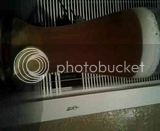spaceyaquarius
Well-Known Member
I have also placed other home brewing info and problems just for FYI for anyone who may be able to glean some information from the mistakes that I have made.
Overcarbonation is strange,
Make sure your beer line length and inner diameter is correct first. Also, submerge your keg in a bathtub after you pressurize it with 20 PSI (empty) to check for leaks and also submerge the pressurized quick disconnects into a glass of water to check for leaks on that side.
Check the later posts below on this post. Typically you will want 3/16" inner diameter (ID) and 7 feet to 10 feet of length (usually 10 feet length and then you can cut it down depending on your style of beer). If you have 1/4" inner diameter hoses, then the length will change, but there are tables to reference, though most home-brewers claim that inner diameter (ID) 3/16 inch with a 10 foot long length of beer lines is the way to go. if you know your beer lines are correct (mine are 3/16" with 10 feet length) but you still pour a foamy glass (not the 1st warm beer lines foamy glass) and it tastes flat then you overcarbed. Too short of beer lines can pull CO2 out of the liquid beer, so fix this issue first. Flat tasting beer because the CO2 came out of the liquid beer and may turn into foam before you could drink it. Short beer lines can do the same thing, but you can also overcarb with short beer lines. Some pours will have 2-3" of head, then some pours will have 1" of head, some pours will have almost no head but still can be overcarbed. The head you do have will decrease quickly, and other times my overcarbed kegged beer had high head retention.
At first I thought that it was not overcarbed bc the head was not too high after 3 glasses and there were not enough CO2 bubbles rising to the top of the glass (off-gassing) even versus a commercially bottled beer. It was still overcarbed. I added 2 slices of lime and then took a photo and video of what happened. Just look at the hundreds of CO2 bubbles/off-gassing that is occurring!!!
Once I tried 30 PSI for 5 days and overcarbed. Next time I tried 3 days at 25 PSI and overcarbed. 3rd time I tried 10 PSI for 5 days and then 28 PSI for 18 hours and overcarbed. Set it and forget it at serving pressure is really the way to go IMO.
When I tried to disconnect the CO2 tank from the keg (thinking it was overcarbed) and released the pressure twice a day it didn't seem like enough gas was coming out twice a day. I should have kept doing it. It could take days to get the CO2 out of the liquid and into the "head space" of the keg and then out of the valve.
Here is 4 photos and one youtube video of the same pint glass of a Belgian Wheat Ale (Shock-Top Clone) that I overcarbed.




http://www.youtube.com/watch?v=3XixeKTqn2w&feature=em-upload_owner#action=share







